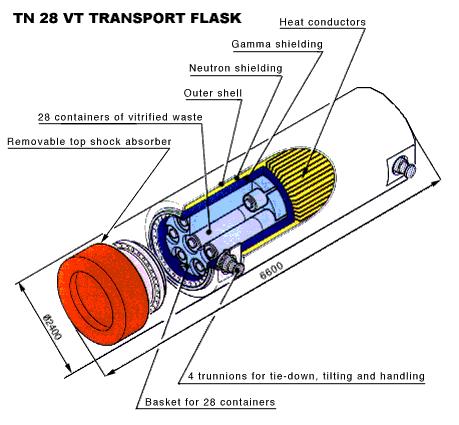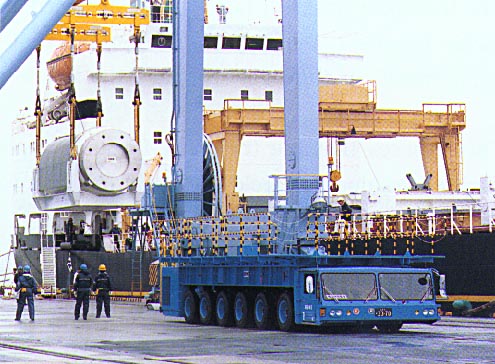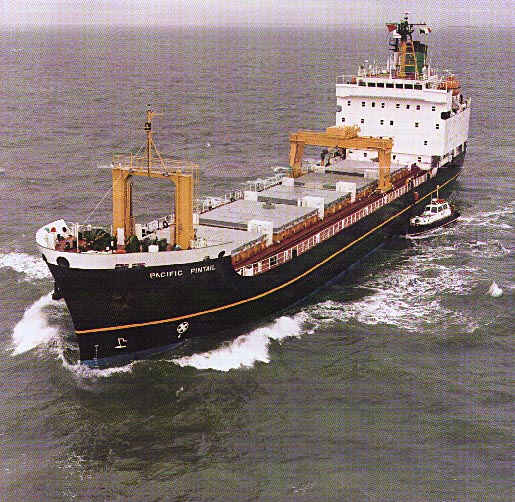Japanese Waste and MOX Shipments From Europe
- From 1969-90 there were more than 160 shipments of used nuclear reactor fuel from Japan to Europe.
- Reprocessing of the Japanese used fuel has been undertaken in UK and France under contract with Japanese utilities.
- Recovered fissile materials are returned to Japan as reactor fuel, notably as mixed oxide (MOX) fuel.
- The first shipment to Japan of immobilised high-level waste from reprocessing took place in 1995 and the 12th and last one from France was in 2007. The first one from UK was in 2010.
Nuclear power provides about one third of Japan's electricity, and with the enhanced efficiency brought about by reprocessing used fuel to recycle the uranium and plutonium, it represents a major part of Japan's endeavours to achieve maximum self sufficiency in energy. Japan plans to have one third of its 53 reactors using some mixed uranium-plutonium oxide (MOX) fuel by 2010.
Reprocessing separates the waste, particularly the high-level waste containing nearly all of the radioactivity in spent fuel, from the uranium and plutonium which are recycled as fresh fuel. Separated high-level wastes – about 3% of the used fuel – remain.
A total of ten Japanese electric utilities had contracts with the French company Cogema (now Areva NC) to reprocess their used fuel. These Reprocessing Service Agreements date from 1977-78. Other contracts were with British Nuclear Fuels Limited (BNFL) in UK and are now held by the government's Nuclear Decommissioning Authority. About 40% of the used fuel involved was reprocessed by Cogema/Areva and the rest by BNFL.
From 1969-1990, some 2940 tonnes of used fuel in total was shipped (in over 160 shipments) by these utilities to France for reprocessing. Shipments of about 4100 tonnes were to the UK, and by mid 2007 more than 2600 tonnes of oxide fuel had been reprocessed there, plus a small amount of Japanese Magnox used fuel.
Reprocessing of Japanese used fuel in France finished in 2004 and all the high-level waste from reprocessing the used fuel in France has now been shipped back to Rokkasho in Japan for long-term (30-50 year) storage prior to ultimate disposal. Waste shipments from the UK should be completed by 2016.
Japan has a small (210 tonnes/yr) reprocessing plant already in operation at Tokai, associated with the Monju fast neutron reactor. A much larger (800 t/yr) reprocessing plant has been built at Rokkasho has been undergoing commissioning activities for some years. The 130 t/yr MOX Fuel Fabrication Plant at Rokkasho is finalising construction and due to enter operation in 2019.
Return of high-level wastes
In February 1995 the first of 12 shipments of vitrified high-level waste (HLW) departed from France for Japan. The last was in 2007. This waste belonged to the ten Japanese power utilities who are responsible for its safe storage and eventual disposal.
The 12 waste shipments over 12 years total 1310 canisters containing almost 700 tonnes of vitrified high-level wastes. These are packed in heavy steel shipping casks (see section on Marine transport below).
|
Year of shipment
|
Number of HLW canisters
from France |
|
1995
|
28
|
|---|---|
|
1997
|
40
|
|
1998
|
60
|
|
1999
|
40 + 104
|
|
2000
|
192
|
|
2001
|
152
|
|
2003
|
144
|
|
2004
|
132
|
|
2005
|
124
|
|
2006
|
164
|
|
2007
|
130
|
|
Total (12 shipments)
|
1310
|
Shipment of the vitrified high-level wastes from UK to Japan commenced early in 2010 and requires about 11 shipments over 8-10 years to move about 900 canisters. Under the Vitrified Residue Returns (VRR) program, some of this HLW will be substituting for a larger volume of intermediate-level wastes, on the basis that a radiologically-equivalent amount of HLW can be substituted in order to minimise the volume shipped. Both UK and Japan have legislation allowing this. The shipments are a continuation of the established waste return program from France. The second shipment arrived in Japan in September 2011; a third arrived in February 2013; the fourth was in April 2014; the fifth in September 2015; and the sixth in September 2016, with 56 canisters of HLW for Tepco, 56 for Kansai and 20 for Japco.
| Year of shipment | Number of HLW canisters from the UK |
| 2010 | 28 |
|---|---|
| 2011 | 76 |
| 2013 | 28 |
| 2014 | 132 |
| 2015 | 124 |
| 2016 | 132 |
| Total (6 shipments) | 520 |
These shipments are received by JNFL's Rokkasho facility which has capacity for 2880 canisters. In September 2015 it had 1698 canisters, 1310 of these from La Hague and 388 from Sellafiield.
Return of plutonium and MOX
So far one shipment of separated reactor-grade plutonium recovered from used fuel reprocessing has been returned to Japan, in 1993. This was reactor-grade material, with about 30% Pu-240 in it and therefore useable only as a reactor fuel. It is not suitable for nuclear weapons.
Further plutonium is being returned as mixed oxide (MOX) fuel, in which the plutonium is mixed with depleted uranium and fabricated into fresh fuel elements ready for use in a power station reactor (see information page on Mixed Oxide (MOX) Fuel). Shipments of MOX fuel assemblies were sent in mid-1999, early 2001, early 2009, mid-2010 and April 2013. Areva uses its TN 12/2 casks of almost 100 tonnes for these. Each can hold eight fuel assemblies.
| Year of shipment | Number of MOX fuel assemblies | kg Pu net |
| 1999 | 30 | 465 minus 255 returned |
| 2001 | 30 | 205 |
| 2009 | 68 | 1721 |
| 2010 | 32 | 1353 |
| 2013 | 20 | 901 |
| Total (5 shipments) | 180 | 4390 |
|---|
Part of the 1999 shipment, intended for Kansai's Takahama plant, was returned to the UK in 2002 due to doubts about quality control. All other shipments were from France.
In 1999 and 2001, the shipments contained 60 MOX fuel assemblies for use in Tepco's Fukishima I-3 and Kashiwazaki-Kariwa 3 BWR units, and Kansai's Takahama 4. The 2009 shipment contained 24 assemblies for Shikoku's Ikata 3, 28 for Chubu's Hamaoka 4, and 16 for Kyushu's Genkai 3. The 2010 shipment from France contained 12 assemblies for Kansai's Takahama 4 and 20 assemblies for the second load at Genkai 3. The 2013 shipment from France was 20 assemblies for Kansai’s Takahama 3.
Vitrification of separated waste
To enable safe storage and transport, the separated high-level waste arising from reprocessing is immobilised in a process known as vitrification. This involves mixing the waste with molten borosilicate glass and poured into 1.3 metre high stainless steel canisters. The waste becomes locked into the matrix of the glass as it cools, making it stable and resistant to leaching. Lids are then welded on to the canisters to seal them.
Each canister contains 150 litres of glass weighing 400 kilograms. Some 14% of the content is high-level waste derived from the reprocessing of about two tonnes of used fuel. After storage for several years, the thermal output of each canister as shipped is less than 1.5 kilowatts.
Marine transport
Shipping casks have been safely transported in the UK, France and Japan as well on long sea voyages for about 50 years. The casks are specially designed for the particular radioactive material they carry, give protection to workers and the public against radiation and are designed to withstand the most serious accidents. The casks are massive steel structures made from 250mm thick forged steel and weigh over 100 tonnes. In the case of spent fuel, each cask typically contains up to eight tonnes of fuel. With vitrified waste, each cask contains 20 or 28 stainless steel canisters of about 500 kg which, in turn, contain the solid vitrified glass waste. The casks used for MOX fuel are similar.


The ships involved are 104-metre, 4900 tonne, specially designed double-hulled vessels used only for the transport of nuclear material. The ships belonging to a British-based company, Pacific Nuclear Transport Ltd (PNTL), have been approved for the transport of vitrified residues, and conform to all relevant international safety standards, notably one known as INF-3 (Irradiated Nuclear Fuel class 3) set by the International Maritime Organization (IMO), a United Nations agency, which regularly reviews its regulations. This allows them to carry highly radioactive materials such as high-level wastes, used nuclear fuel, MOX fuel, and plutonium.
The ships on which the nuclear material is transported have a range of safety features far in excess of those found on conventional cargo vessels:
- Double hulls to withstand collision damage.
- Enhanced buoyancy to prevent the ship from sinking even in extreme circumstances.
- Dual navigation, communications, cargo monitoring and cooling systems.
- Satellite navigation and tracking.
- Twin engines and propellers.
- Additional fire fighting equipment, including a hold flooding system.
They have completed more than 180 shipments and travelled over 10 million kilometres without any incident involving a radioactive release. PNTL is now owned by International Nuclear Services Ltd (INS, 68.75%), Japanese utilities (18.75%) and Areva (12.5%), and its fleet is managed by Serco Ltd. The fleet was renewed over 2008 to 2010. INS is a wholly-owned subsidiary of the UK's Nuclear Decommissioning Authority.
See further details in the information paper Transport of Radioactive Materials.


Further information
General sources
MOX Fuel Transport from Europe to Japan information file (2009 edition), Pacific Nuclear Transport Limited (www.pntl.co.uk)
MOX Fuel Shipments from Europe to Japan fact sheet, Pacific Nuclear Transport Limited (www.pntl.co.uk), produced for the third shipment of MOX fuel from Europe to Japan (March 2009)
Sea Shipments of MOX Fuel to Japan, Media Brief prepared by BNFL, Cogema and Japan's Overseas Reprocessing Committee (January 1999).
Related information pages
Processing of Used Nuclear Fuel
Plutonium
Mixed Oxide (MOX) Fuel
Waste Management in the Nuclear Fuel Cycle
Nuclear Power in Japan
Transport of Radioactive Materials
Appendices
Japanese Waste and MOX Shipments from Europe - Appendix 1Related information
Mixed Oxide Fuel MOXJapan: Nuclear Power
Processing of Used Nuclear Fuel
Plutonium
Radioactive Waste Management